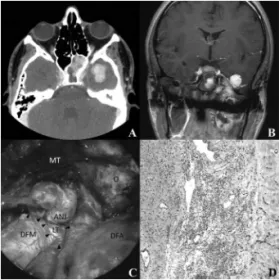Braz. j. . vol.77 número5
Texto
Imagem

Documentos relacionados
9 Preoperative coronal section computed tomography highlighting the right sphenoid heterogeneous opaci fi cation with signs of remodeling in the wall of the sphenoid sinus and
Contrast-en- hanced CT of the abdomen, in the axial plane ( A ) and in coronal reconstruction ( B ), showing extensive retroperitoneal lymph node involvement (arrows) and
MRI revealed a right paraverte- bral mass, with intradural and foraminal components, showing a signal that was, in comparison with the muscle signal, pre-
Nasal endoscopic examination showed a relapsing tumor and CT scans revealed a then T3 neoplasm (the tumor involved the nasal cavity, the ethmoid sinus, the sphenoid sinus, and
Tumor involving the lateral, inferior, superior, anterior, or pos- terior walls of the maxillary sinus, the sphenoid sinus, and/ or the frontal sinus, with or without involvement of
A: (Left) axial CT scan of sinuses shows complete opa- ciication of the left sphenoid sinus with dehiscence in the left optic canal (white arrow), opticocarotid recess (black
Computed tomography (CT) evidenced a lesion with soft tissue consistency at the ethmoid, right maxillary sinus, and nasal cavity, showing erosion of the lamina papyracea,
JNA with erosion of the skull base and minimal intracranial extension, meeting criteria for grade IIIa of the Radkowski classiication.. According to the adopted categorization